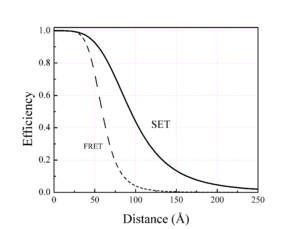
Surface energy transfer (SET) is a dipole-surface energy transfer process involving a metallic surface and a molecular dipole.
Formula
The SET rate follows the inverse of the fourth power of the distance
where
- is the donor emission lifetime;
- is the distance between donor-acceptor;
- is the distance at which SET efficiency decreases to 50% (i.e., equal probability of energy transfer and spontaneous emission).
Efficiency
The energy transfer efficiency also follows a similar form
Due to the fourth power dependence SET can cover a distance more than 15 nm, which is almost twice the efficiency of FRET. Theoretically predicted in 1978 by Chance et al. it was proved experimentally in 2000s by different workers.
Applications
The efficiency of SET as nanoruler has been used in live cells.
Gold nano particles are frequently used in these studies as the nanoparticle surface.
See also
References
- Christopher J. Breshike; Ryan A. Riskowski & Geoffrey F. Strouse (2013). "Leaving Förster Resonance Energy Transfer Behind: Nanometal Surface Energy Transfer Predicts the Size-Enhanced Energy Coupling between a Metal Nanoparticle and an Emitting Dipole". J. Phys. Chem. C. 117 (45): 23942–23949. doi:10.1021/jp407259r.
- C. S. Yun; et al. (2005). "Nanometal Surface Energy Transfer in Optical Rulers, Breaking the FRET Barrier". J. Am. Chem. Soc. 127 (9): 3115–3119. doi:10.1021/ja043940i. PMID 15740151.
- T. L. Jennings; M. P. Singh & G. F. Strouse (2006). "Fluorescent Lifetime Quenching near d = 1.5 nm Gold Nanoparticles: Probing NSET Validity". J. Am. Chem. Soc. 128 (16): 5462–5467. doi:10.1021/ja0583665. PMID 16620118.
- R. Chance; A. Prock & R. Silbey (1978). "Molecular Fluorescence and Energy Transfer Near Interfaces". Adv. Chem. Phys. Advances in Chemical Physics. 60: 1. doi:10.1002/9780470142561.ch1. ISBN 978-0-471-03459-9.
- Yan Chen; et al. (2010). "A Surface Energy Transfer Nanoruler for Measuring Binding Site Distances on Live Cell Surfaces". J. Am. Chem. Soc. 132 (46): 16559–16570. doi:10.1021/ja106360v. PMC 3059229. PMID 21038856.

 is the donor emission lifetime;
is the donor emission lifetime; is the distance between donor-acceptor;
is the distance between donor-acceptor; is the distance at which SET efficiency decreases to 50% (i.e., equal probability of energy transfer and
is the distance at which SET efficiency decreases to 50% (i.e., equal probability of energy transfer and 